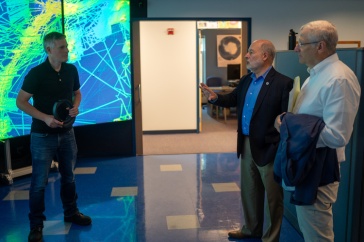
UNH astrophysicist Harlan E. Spence was one of four panelists at a Capitol Hill briefing Tuesday, March 24, on “super storms” that can have profound effects on America's economy, public safety and well-being.
The noon lunch briefing, “Super storms: Risk and Resilience,” was held at the Senate Visitor's Center and focused on tornados, hurricanes and “space weather” storms. Spence, director of the UNH Institute for the Study of Earth, Oceans, and Space, detailed how violent solar eruptions create space weather that can influence the performance and reliability of space- and ground-based technological systems and endanger human life and health.
Says Spence, “Over the past century we have become an electric-based and space-faring nation dependent on technologies and infrastructures vulnerable to space weather and the societal implications it can have on electric power distribution, communication, navigation, emergency response systems and national security.”
Sponsored by the National Science Foundation and the American Association for the Advancement of Science, the closed briefing for some 100 members of Congress provided an overview of the current state of storm research and highlighted NSF research in geosciences that has particularly high practical value to the nation. In particular, panelists discussed work to improve risk assessment and hazard preparedness in order to mitigate vulnerability to storm impacts.
According to Spence, space weather storms occur because the sun’s explosive solar flares and coronal mass ejections (CME) send billions of tons of high-energy particles and intense electromagnetic fields streaming towards Earth — a “pebble in the stream” of the sun’s powerful energy — which can create dazzling auroras but also disable satellites and Earth-based power grids. Under the right circumstances such storms can wreak havoc as well as pose risks to astronauts and passengers in polar-orbiting aircraft.
Indeed, as Spence detailed during the briefing, in 1859 the sun unleashed a furious CME that produced the so-called “Carrington Storm” at Earth and created auroras so bright that newspapers could be read under night skies and telegraph systems across Europe and North America were brought down. In 1989, a weaker CME left millions in Quebec in darkness with damage of $4-10 billion. A 2009 National Academy of Sciences study estimated that were an event the size of the Carrington Storm to occur today, it could have an economic impact of over $2 trillion.

“The ultimate space weather super storms to the point of predictability and to understand the full range of storm size and frequency of occurrence,” Spence says.
To that end, the United States created an interagency initiative known as the National Space Weather Program in 1994 with the overarching goal of “achieving an active, synergistic interagency system to provide timely, accurate and reliable space weather warnings, observations, specifications and forecasts.”
But as Spence notes, with limited knowledge of the sun’s past super-storm history, society is largely in the dark as to what our star is capable of and with what type of frequency. “What we don’t know will hurt us, so it is imperative that we continue to develop the basic understanding, based on observation and theory, so that we can produce the next generation of improved predictive models to mitigate the risks of space weather.”
Other briefing panelists included Roger Wakimoto, assistant director for geosciences at the NSF, Jenni L. Evans, acting director of the Institutes of Energy and the Environment at Penn State and professor Howard B. Bluestein of the University of Oklahoma School of Meteorology.
-
Written By:
Tracey Bentley | Communications and Public Affairs




















































